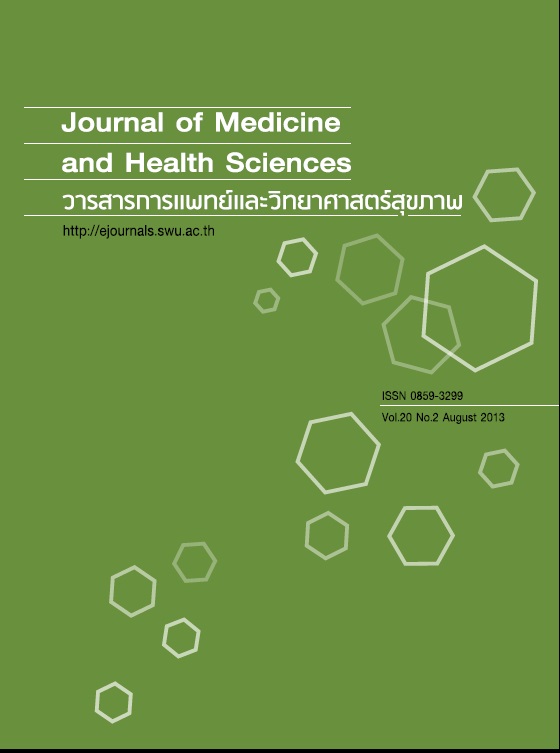Medical Mycology
Keywords:
พิษรา, ภูมิแพ้รา, ยาต้านเชื้อรา, Mycotoxicosis, Fungal allergy, Antifungal drugsAbstract
Mycoses are the infectious diseases caused by fungi. Fungi have been divided according to their morphology into 3 types: yeasts, molds, and dimorphic fungi. Fungi are everywhere including in the environment, and on humans and animals. Diseases by fungi can be occasioned either directly (mycoses) or indirectly (poisoning and allergy). Mycoses are classified by the level of invasion and degree of infected tissue as superficial, cutaneous, subcutaneous and systemic (deep) mycoses. Besides, some fungi can release the fungal metabolites (secondary products of metabolic processes), called mycotoxins, that are capable of causing disease and death called mycotoxicosis. In addition, fungi may trigger an allergic reaction in some humans and other animals. The pathogenesis of fungal infections depend on 2 main factors, the fungal virulence factor and host immune status, especially, innate immune response cells. At present, there are several diagnostic methods for fungal infection, mostly depending on microbiology techniques such as potassium hydroxide (KOH) direct examination of the lesion, which may be stained with lactophenol cotton blue and Gomori methenamine silver stain etc. The other variety of fungal diagnostic tools has been developed for several fungal infected samples such as fungal cultivation, fungal composition based diagnostic tools (galactomanan, β- D glucans), serodiagnosis and molecular based technique (Polymerase chain reaction, PCR). In the treatment of fungal infections, there are 6 types of antifungal agents that commonly used for fungal infected patients, which are polyene, azoles, pyrimidine analog, echinocandins, allylamine and others. The effectiveness among these groups vary according to their inhibition site. Moreover, the form of medication applied either topical or systemic (oral and injection), has to be considered depending on individual fungal pathogen and disease severity.
เชื้อราทางการแพทย์
โรคติดเชื้อรา (mycoses) จัดเป็นโรคที่เกิดจากจุลชีพกลุ่มเชื้อรา ซึ่งหากแบ่งตามรูปร่างจะสามารถจัดจำแนกได้ 3 ชนิด คือ เชื้อส่ารา (yeast) ราสาย (mold) และราสองรูป (dimorphic fungi) เชื้อราสามารถพบได้ทั่วไปทั้งในธรรมชาติ คนและสัตว์ ความผิดปกติที่เกิดขึ้นจากโรคติดเชื้อราในคนเกิดได้ทั้งทางตรงและทางอ้อม การติดเชื้อราโดยตรงสามารถแบ่ง ความรุนแรงตามความลึกของการเจริญในเนื้อเยื่อหรืออวัยวะที่ติดเชื้อออกได้เป็น superficial mycoses, cutaneous mycoses, subcutaneous mycoses และ systemic (deep) mycoses นอกจากนี้เชื้อรายังสามารถทำให้เกิดความ ผิดปกติทางอ้อมได้ เนื่องจากเชื้อราบางชนิดสามารถปล่อยสารที่ได้จากกระบวนการเมตาบอลิซึ่มของเชื้อรา เรียกว่า พิษรา (mycotoxin) ส่งผลให้เกิดความผิดปกติที่เรียกว่า โรคพิษจากเชื้อรา (mycotoxicosis) อีกทั้งเชื้อรายังสามารถก่อให้เกิด ความผิดปกติที่มีลักษณะคล้ายโรคภูมิแพ้ เรียกว่า ภูมิแพ้รา (fungal allergy) ได้เช่นกัน สำหรับพยาธิกำเนิดกับความรุนแรง ของโรคติดเชื้อรา พบว่ามีความสัมพันธ์กับ 2 ปัจจัย คือ ตัวเชื้อรา โดยเฉพาะ virulence factors และระบบภูมิคุ้มกันของ โฮสต์ โดยเซลล์ระบบภูมิคุ้มกันที่มีผลต่อพยาธิกำเนิดของเชื้อรามักอยู่ในกลุ่มของ innate immune response cells การตรวจวินิจฉัยเชื้อราในปัจจุบันมีหลายวิธี ที่นิยมคือวิธีการทางจุลชีววิทยา เช่น การตรวจหาเชื้อโดยตรงโดยใช้สาร โปแตสเซียมไฮดรอกไซด์ (KOH) และการย้อมสีพิเศษ เช่น Lactophenol cotton blue และ Gomori methenamine silver stain นอกจากนี้ยังมีการพัฒนาวิธีการตรวจที่จำเพาะเจาะจงเพิ่มมากขึ้น เช่น วิธีการเพาะเลี้ยงบนวุ้นเพาะเลี้ยง (fungal culture) และวิธีการตรวจอื่นๆ เช่น การตรวจหาจากส่วนประกอบของเชื้อรา (galactomanan, β -D glucans) การตรวจทางซีโรโลยี (serological test) รวมถึงการตรวจทางอณูชีววิทยา (Molecular technique เช่น Polymerase chain reaction; PCR) ด้านการดูแลรักษาผู้ติดเชื้อราในปัจจุบัน มียาที่ใช้รักษาอยู่ 6 กลุ่ม คือ polyene, azoles, pyrimidine analog, echinocandins, allylamine และ ยากลุ่มอื่นๆ โดยมีรูปแบบของยา 2 รูปแบบ คือ ชนิดทาและ ชนิดที่ออกฤทธิ์ทั่วร่างกาย ทั้งนี้การเลือกใช้ชนิดและรูปแบบของยาในการรักษาผู้ป่วย ขึ้นอยู่กับชนิดของเชื้อและความ รุนแรงของโรคในผู้ป่วยแต่ละราย



